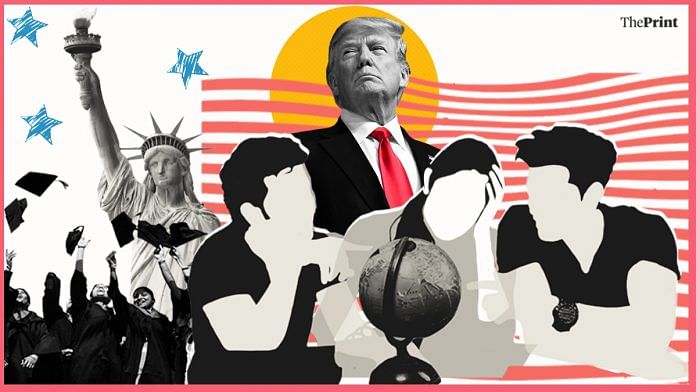The Narendra Modi government replied to an unstarred question in the Lok Sabha Monday, that there was a decline in the number of Indian students who went abroad in 2018-19. It is particularly stark for American universities where compared to 4,47,836 in 2017-18, only 2,09,063 Indian students went to the US.
ThePrint asks: Fewer Indians in US universities in 2018-19: Trump’s policies making America less popular?
If US was unpopular under Trump, there wouldn’t still be lakhs of Indian students studying there

Kanwal Sibal
Executive council member, VIF, and former foreign secretary
If the US had become a less popular destination for international students because of Trump’s policies, then there wouldn’t be lakhs of Indian students studying there. The percentage of increase in the number of Indian students has declined, but India is nonetheless the second-largest source of international students opting for the US.
The growth in numbers was 5.4 per cent in 2017-18, down from 12.3 per cent in 2016-17 and 29.4 per cent in 2015-16.
Indian students constituted nearly 18 per cent of total foreign students in the US and contributed $7.5 billion to the US economy in 2017-18.
It is true that the atmosphere in the US for foreigners appears less friendly because of Trump’s overtly anti-immigrant policies, and there is the added factor of the tightening of H1B visas. Both send negative signals, which may partially explain the decline in the annual growth of admission seekers from India.
According to the US 2019 Open Doors Report, the number of Indian graduate students seeking admission has dropped by 5.6 per cent, but at the undergraduate level, in mathematics, computer science and engineering, the number has increased by 6.3 per cent.
Another factor responsible for the decline in the numbers has been increasing opportunities in other English-speaking countries.
Rise of dollar against rupee & Trump tightening post-study work visas have forced Indians to look elsewhere

Manisha Priyam
Political analyst
Donald Trump’s America has indeed become less attractive for Indian students. India has been the second-largest country sending students to the US, just behind China. But India’s ranking could be threatened.
American universities have become increasingly reliant on income from overseas students as their operational costs have increased and state support for universities has declined.
In his populist promises to save blue-collar jobs for natives in factories, US President Donald Trump has managed to convince the unemployed American youth that immigrants like Indians are responsible for snatching jobs.
The deciding factor has been the tightening of post-study work visa regimes by the Trump administration. As a result, pursuing higher education in the US has no longer remained an economically viable option.
Indian students spend a fortune on acquiring a US degree. But recovering the costs of their American education becomes difficult when they are not offered jobs in the US. The rise of the dollar against rupee has been another factor that has made American education very expensive for Indian students.
Besides, the socio-cultural atmosphere in the US is no longer accepting of Indians working there. There have been cases of violent attacks on Indian techies. Indians have been subjected to hate, which is forcing some of them to leave the US.
For Indian students today, Canada and Australia are far more attractive destinations because they are more tolerant of immigrants.
Perception that US universities aren’t attractive is misplaced

Srijan Shukla
Reporter, ThePrint
The growing perception that the US is no longer an attractive destination for Indian students because of Trump’s policies is misplaced. Such a notion doesn’t take into account how Trump hasn’t changed some fundamentals of the US education system or its economy.
The US continues to, by and large, have the best universities in the world. So much so that leaders of the Chinese Communist Party, including President Xi Jinping, prefer to send their children to Harvard and Princeton.
Additionally, no other country in the world has enough funds available for research. Just contrast the number of research assistants working for a celebrity professor in the US with the ones in Canada or Germany.
Moreover, when it comes to high-tech research, the US is still the global leader. Be it John Hopkins Genomics or MIT’s artificial intelligence department, the US is still leading in race of countries with most cutting-edge research.
It is true that Trump’s trade and immigration policies are beginning to hurt the US economy. But the impact is far from uniform. For instance, the rise in tariffs are hurting US’ manufacturing towns and the average consumer, but they are neither hurting the Wall Street nor Silicon Valley.
Thus, when it comes to either banking or tech services, the US still provides the best job market in the world. And needless to say, A-list US universities are the best bet to enter that job market.
Trump’s immigration policy, visa scrutiny & H1B visa fee hike are some factors to blame

Robinder Nath Sachdev
President, The Imagindia Institute
Trump’s immigration policies are having an impact on the number of international students choosing to study in the US. However, this isn’t specific to Indian students.
There has been an overall tightening of immigration procedures. The cost of the H1B visas has increased, after which Indian students feel less enthusiastic about pursuing jobs in the US.
The state of the economy has anything to do with fewer number of jobs being offered since the US economy is doing very well. The primary problem is the policies of the Trump administration.
The increased focus on national security measures to combat terrorism cannot be discarded either. Consequently, visa scrutiny has become more stringent, a factor that students do consider while deciding whether to go to the US or not.
The emergence of alternative destinations that are marketing themselves better is another reason why the popularity of American universities is declining. It is not just English-speaking nations anymore but countries like Japan, Singapore and South Korea are also accepting Indian students. Some countries are forced to invite professional immigrants because of ageing demographics. Japan has reached a critical point where it is having to modify its immigration policies. Therefore, countries like these are fast becoming popular destinations for Indian students.
There are other factors at play. Ugly nationalism leads to hate crimes. However, this issue is not specific to the United States. This is happening in other countries too.
Indian students contribute to US govt revenue, but Trump chooses to view this from the lens of immigrants

Vanita Shastri
Dean, Global Education and Strategic Programs, Ashoka University
US President Donald Trump’s policies have certainly had an impact on America becoming a less attractive destination for Indian students. I say this based on my own experience and interactions with other immigrant students there. Post Trump’s election, there has been an increase in immigrants being viewed as the ‘other’.
In terms of policies, it is not so much Trump’s education-related regulations but his immigration rules that have adversely affected Indian students.
Visas are strongly linked to the way people look at pathways to higher education. In the UK, Theresa May government’s policies were stringent to the extent that international students were forced to return home after completing their studies. The share of Indian students in the total number of foreign students in the UK declined rapidly by 2016, registering a mere 6 per cent.
Higher education import for countries like the US is very profitable. Indian students have spent as much as Rs 44,000 crore, which is a huge monetary boost to these countries. Trump’s office is clearly not connecting the dots. Higher education is a source of revenue for the US government, but the Trump administration chooses to view incoming international students from the lens of immigrants alone.
Also read: Australia wants to set up university campuses in India as Modi govt changes rules
By Kairvy Grewal, journalist at ThePrint




Thanks God. Less is better.
Money and talent both required
Give some on the Left the opportunity to spout off, and they would end up blaming Trump for stubbed toes and flatulence in addition to everything else that they need a scapegoat for. Indian students have historically either come to top US universities, or have made it to regionally accredited and even fake institutions in some cases in what can only be called diploma-shop rackets. The lure of a US visa and previously lax US work-visa laws have left as many Indians driving for Uber and Lyft as there are “techies” writing code at a little above the minimum wage for exploitative corporations here. The bargain that the disadvantaged lot makes is that an American minimum wage plus 20% is still worth more than what might be earned in India, and there’s always a dowry to count on with a “US employed groom” status. Tougher vetting procedures (that actually were initiated halfway through Obama’s second term, before they were implemented under Trump) ended many of the rackets. The flow of students who did well in India and who earned acceptance at good universities has not been affected one bit.
The fact also is that there are other countries with very strong establishments and educational traditions in certain areas that Indians did not even know of earlier – Canada, for example, has strengths in neuromedicine, robot-assisted surgery, and Artificial Intelligence that rival the US, and precede American advances in these fields by a decade or more in some cases. Canada has the world’s safest nuclear powerplants, all of which are locally designed and engineered, it’s Hydel plants are also among the finest engineered in the world – you won’t find a Three Mile Island type disaster in Canada if you look that country’s nuclear powerplant history up, for example. The modem and the smart phone were both invented in Canada, too, before Nortel closed down, and Blackberry became an also ran after becoming unable to compete with rivals. If Google and Microsoft have large development centers under construction in Canada at the moment, it is because of the amount of talent available there, as well as because a shortage of educated professionals makes it easy for them to hire Canadian-educated professionals under Canadian Express Entry and Canadian Experience regulations. Other countries have similar strengths that are only now becoming known in India, and those who want to specialize in these niches where they might get fee discounts at universities and easier post-diploma work opportunities, are likely to look at options other than the US.
The US will always remain the top draw for students interested in studying and working in several fields where American universities are strong. There are strengths this country has that no other country in the world can boast of, and that will always draw some of the smartest students from every country on earth over here. We do not live in a unipolar world, though, and this applies as much to education as it does to everything else.
At this point Canadian Universities such as University of Toronto or McGill University offer better value for money in the long run. The Universities are highly rated, the country is too big with too few people, which makes it an ideal place to reside. Many Indians are now aware of the value offered by German universities. With PSW coming back in the UK from 2020, a large number might invest in a UK degree once again. However, ‘meaningful jobs will be available only to those who can demonstrate exceptional skills acquired from top 10-15 universities. Rest can expect low paying jobs. As far as the US is concerned, the appeal lies in high quality education and the country’s ability to absorb migrants. Though it seems less friendly at present, it could revert to its earlier position as the most lucrative destination, though nOT necessarily in terms of quality of life offered by Canada.
Perhaps less accessible as well. Tourist arrivals to the US have also fallen, due to more stringent visa procedures. It remains to be seen whether the United States is turning its back to the world or some of these aberrations will abate when President Trump leaves, hopefully in November 2020.